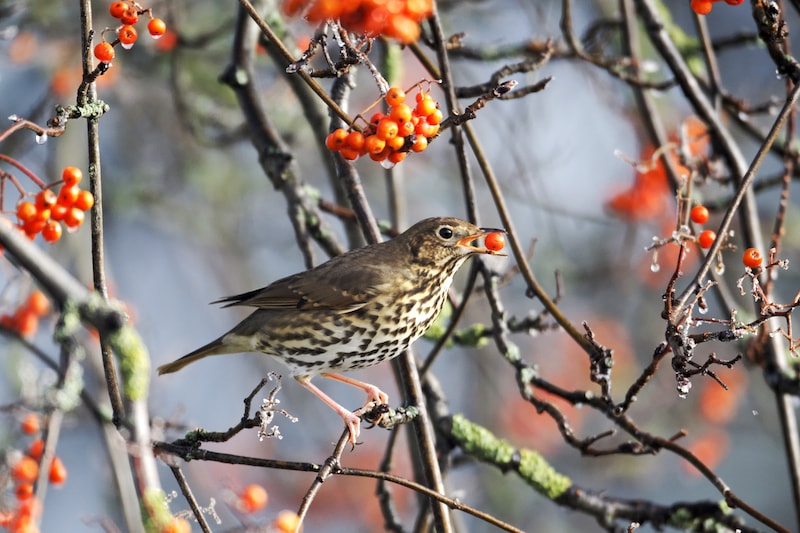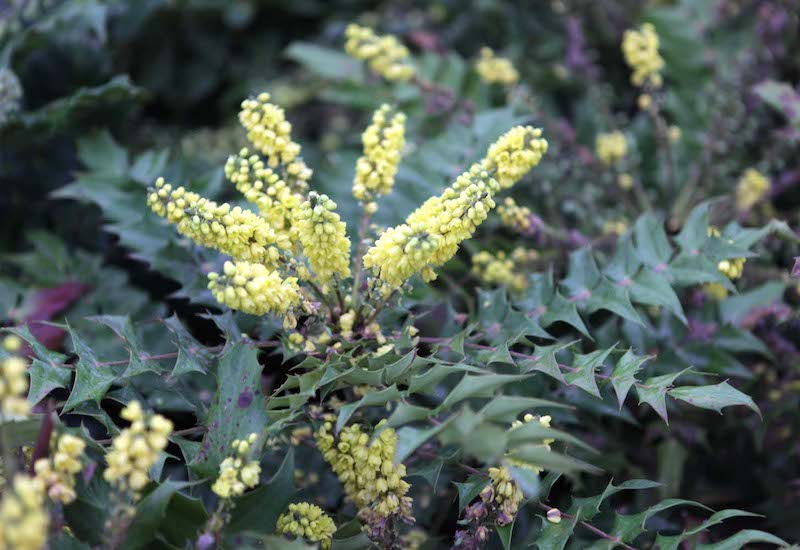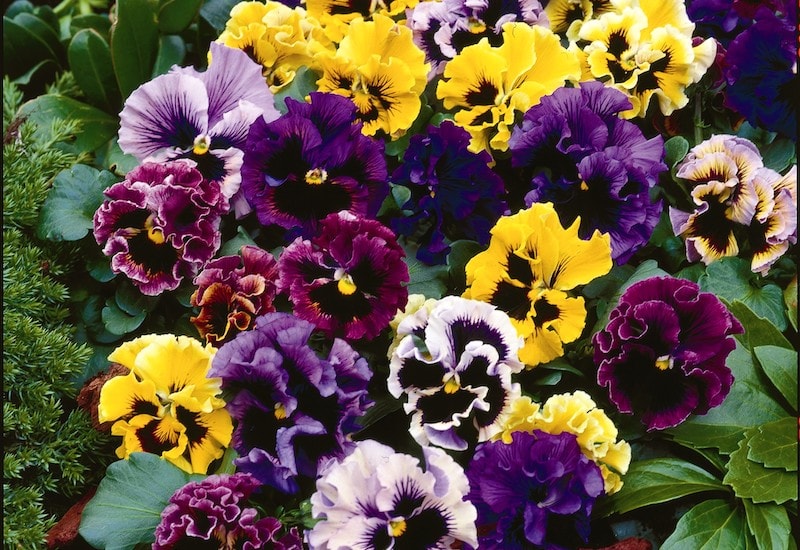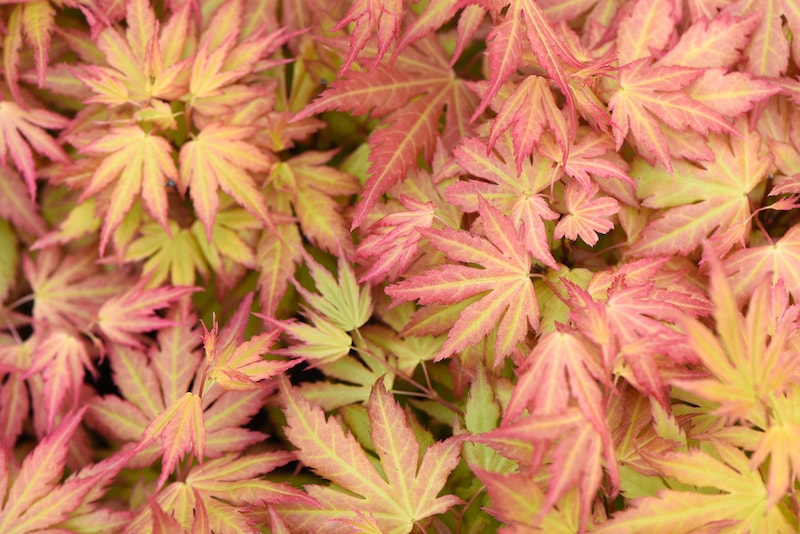Designing a beautiful autumn garden is all about stage-managing the transition from summer pastels to the deeper and richer hues of red, gold, bronze and purple. Showcasing breathtaking autumn foliage against a structural background of evergreen leaves really helps the colours to pop. Here’s a selection of trees, shrubs, border perennials, bedding plants and bulbs that add seasonal spectacle to your autumn garden.
For a quick fix, browse our range of autumn and winter bedding plants for instant impact.
Best trees for autumn colour

Not everyone relishes the prospect of dealing with fallen leaves, but not only do many deciduous trees look fabulous in the autumn, leaf fall is very beneficial for your garden. Dead leaves are the ingredient for making leaf mould; they’re also great for use as a mulch. You can mow them into your lawn, add them to your compost or pile them up to make a perfect hotel for over-wintering bugs, reptiles and mammals. Here are some of the best trees for autumn displays.
- Rowan – Also called mountain ash, rowan trees are native to the UK. During the spring, white flowers appear, turning to bright red berries as autumn arrives, and as the leaves yellow and fall, an array of wild birds, from blackbirds and mistle thrushes to redstarts, redwings, song thrushes, fieldfares and waxwings will arrive to gorge on the fruit. You can also harvest some of the berries yourself to make traditional rowan jelly. Raw berries are inedible, but deep orange rowan jelly is the perfect accompaniment for lamb, game and cheese.
- Acer– Also called Japanese maple, acers are perfect for growing in a sheltered, lightly shaded spot in the garden and also make excellent container plants. With distinctive leaves and a light, airy canopy, they’re a lovely addition to any garden. Come the autumn, their fiery autumn foliage offers natural fireworks that are hard to beat.
- Beech – You can grow copper beech as a tree or for hedging. Leaves are deep purple during the spring and summer but turn a delightful shade of copper brown as autumn arrives. Clipped hedges retain their leaves all through the winter, forming a dense screen that’s great for privacy and also benefits birds and other wildlife.
- Holly– As other trees lose their leaves during late autumn, evergreens like holly come into their own, providing a vibrant splash of deep green colour and bright red berries just when you need it. Some holly varieties require two plants to produce berries, which makes them perfect for growing in pairs. Plant as small trees, hedging, or use potted holly to frame doorways and entrances.
- Black Gum – Slow-growing black gum, or Nyssa sinensis, has a conical shape, sweeping branches, and leaves which, during the autumn, turn a variety of gold and red before finally dropping. Native to America, where it’s called Tupelo, this tree likes rich soil and a sheltered position.
Best shrubs for autumn colour

With their vibrant foliage and berries, shrubs give your autumn garden vital architectural structure. Here’s a selection of evergreen and deciduous shrubs that really come into their own as summer fades.
- Cotoneaster – Tough, resilient, and vigorous, this shrub prefers well-drained soils but isn’t fussy about soil quality. It provides dark green foliage all-year-round, with attractive small white flowers in the spring, which develop into bright red berries in time for a lively autumn display. A favourite with birds, cotoneaster is also known as bearberry and is an excellent low-maintenance option for gardeners with little time to spare.
- Mahonia japonica Hivernant – One of the more unusual evergreen shrubs, sharp, glossy, dark green leaves give your garden colour all through the year, but from November through to March, lemon-yellow flowers appear on arched racemes to give your late-autumn garden the colourful lift it needs. A perfect shrub for larger gardens and mixed borders, dark blue berries add summer interest.
- Rhus typhina ‘Tiger Eyes’ – For autumn spectacle, look no further than this beautiful shrub. Its fern-like leaves provide rich golden colour during the spring and summer months, but as the days turn cooler and the evenings lengthen, the foliage transforms into a blaze of stunning red colour.
- Pyracantha – Perfect for thorny hedging, during the autumn this shrub produces berries that vary in colour from bright yellows and oranges to vibrant red. Great for training against a wall or fence, Pyracantha likes well-drained, moist soil in sun or semi-shade. Plant in a sheltered spot away from cold, drying winds.
- Fothergilla – This deciduous shrub features scented white bottlebrush flowers from late spring to early summer, but it’s in autumn that it comes into its own. From September until its rounded leaves fall, the foliage of Fothergilla major transforms into vibrant shades of fiery red and orange. Also called Mountain Witch Alder, this slow-growing shrub thrives in rich, leafy, ericaceous soil and looks best in borders or along the edges of woodland plantings. While it can tolerate light shade, Fothergilla thrives best in a sunny spot.
- Cornus – This deciduous shrub generates oval green leaves and also forms clusters of white blossoms at the beginning of summer. As autumn arrives, the foliage becomes increasingly vibrant, transitioning into yellow tones before exposing the stems, which are Cornus’ main attraction. Vibrant and flame-hued, they bring winter radiance to your garden during late autumn and right through the dark winter days and will keep doing so year after year, as long as you remember to cut them right back each year.
Best border perennials for autumn colour

Tough and reliable, autumn border perennials extend summer colour into the darker months, providing a stunning late display before winter finally arrives.
- Bergenia – Also called ‘elephant’s ears’, Bergenia is a cottage garden favourite and perfect for your autumn borders. A dependable plant, during the spring it boasts vivid pink blooms on erect, red-hued stems, and then as summer gives way to autumn, the glossy green foliage turns attractive shades of pinky red. Bergenia likes a sunny or partially shaded position and is a good choice for those gardening clay soils.
- Helenium – An indispensable source of rich late summer and early autumn colour, varieties like Helenium ‘Moerheim Beauty’ offer captivating copper-red blooms and are a favourite with bees and butterflies, too. As a taller flower which grows up to 3ft in height, it’s a great choice for plugging the gaps in your borders and adding vertical interest. This resilient perennial prefers a sunny spot in rich, moist soil.
- Chinese Lanterns – Physalis alkekengi var. Franchetii (also called Cape Gooseberry) flowers in June and July with cream-coloured blooms but is notable for its remarkable coral-coloured papery calyces resembling Chinese lanterns, which really are an autumn show-stopper. A low-maintenance plant, this perennial thrives in dappled sun and looks incredible as a specimen plant or, equally, as a cottage garden stalwart.
- Rudbeckia – Easily distinguished by their vivid yellow daisy-like petals encircling a dark conical centre, Rudbeckia is an excellent way to bring a splash of cheerful colour to your autumn garden. The blooms are a favourite of bees, butterflies and other pollinators and also make excellent cut flowers that last well indoors. Plug plants benefit from a spell in a greenhouse before planting out.
- Sedum – As summer draws to a close, this interesting plant with leaves that range from fleshy green to purple-black develops copious pollinator-friendly red flower heads. A very hardy perennial sedum looks exotic but is as tough as old boots, thriving in warm borders with lots of sunshine. Plant in well-drained, rich soil and apply compost regularly.
Best bedding plants for autumn colour

Autumn and winter bedding plants bring a splash of welcome colour to your beds and borders. Relatively inexpensive to buy and easily replaced, bedding plants are a sure-fire way to add instant interest to your garden this season.
- Heuchera – Great for softening the fronts of your borders and cherished for its ability to bring year-round colour, shade-loving heuchera is a particularly good choice for anyone tending a patch that’s low on sunlight. These perennials produce nectar-rich blooms during late spring and summer and look best when planted en masse to create blocks of striking colour. Choose from variegated foliage in pinks, greens, purples and more – this autumn bedding plant is a must.
- Cyclamen – An autumn bedding plant that’s perfect for rock gardens and woodland settings, cyclamen blooms in autumn through to spring, providing a pretty carpet of delicate pink flowers with turned-back petals. After flowering, these lovely plants continue to add interest with their deep green heart-shaped leaves with silver patterning.
- Pansies – For autumn bedding, pansies are hard to beat. Offering a tremendous colour boost from autumn all the way through the winter, these tough little flowers are a must for gardeners everywhere. Suitable for beds, borders, pots and hanging baskets, whenever you feel the need for a splash of extra colour during the darker months, pansies are a great option.
- Asters – Also commonly known as ‘Michaelmas daisies’, plant asters for a profusion of pink, purple and white blooms right in time for the September equinox. A low-maintenance, hardy flower that grows to a maximum height of around 3ft, asters are pollinator-friendly and also make excellent cut flowers. They like sun or dappled shade and rich, well-drained soil which is reasonably moist.
- Verbena bonariensis – Flowering from June through to November, this plant’s long blooming season makes it a perfect choice for extending summer colour right through to late autumn. Boasting tall stems and clusters of delightful pink flowers, Verbena bonariensis carries a subtle scent and is a perfect way to add height to beds, borders and patio displays.
Bulbs for autumn colour

Traditionally associated with spring, there are plenty of autumn and winter-flowering bulbs that provide a striking spectacle when other flowers have faded.
- Nerine ‘Bowdenii’ – If it’s drama you’re looking for, try Nerine ‘Bowdenii’. Nerines are a great bulb for brightening up your autumn borders. Also called Guernsey lilies, they boast lovely funnel-shaped blooms in a range of hues, from bold magenta to subtle pinks and whites. A hassle-free bulb, they’ll grow in the greenhouse, borders, pots, and container displays, where they’ll thrive as long as there’s decent drainage. Plant in clumps for best effect.
- Crocus – Autumn-flowering saffron crocus brings delightful lavender hues to your autumn beds, borders and pots, with the vibrant, deep crimson stigma adding even more colour. Also, as the most expensive spice in the world, why not harvest the saffron for use in paellas, saffron buns and other tasty recipes? Crocuses may not flower in their first year, but once they do, they produce up to six flowers and will bloom over a 40-day period.
- Amarcrinum howardii – Wonderfully fragrant and a beautiful cut flower, Amarcrinum bulbs are a cross between an amaryllis and a crinum and produce bold lily-like flowers during the summer and autumn. A tall flower that reaches a maximum height of 70 – 80 cm, plant this bulb in well-drained soil or containers and enjoy.
- Oxalis – A delightful perennial with unusual, hairy leaves; choose varieties with pink, white or yellow flowers. This bulb is mat-forming and a great choice for creating dense blocks of colour.
- Acidanthera Murielae – For a lovely fragrance and a long-lasting cut flower, Acidanthera Murielae makes a great choice. Tall flowers which reach up to a metre in height, the blooms are white with attractive dark purple centres. For best results, plant in groups in a warm, sunny, sheltered position. Originally from East Africa, make sure you lift these corms after flowering and, after removing the remains of the foliage, store them in a reasonably warm, dry place until May, when the frosts have passed.
There’s no need for autumn to be a dull time in the garden when there are so many late bloomers and winter-flowering plants to choose from. If you’d like to know more about sowing flowers for year-round colour, please head over to our guide to when to sow flower seeds for flowers to plant in every month.
Lead image: Acer palmatum ‘Orange Dream’ from Suttons/©Branded Garden Products
Last Updated on October 27, 2025 by Suttons Horticultural Team





